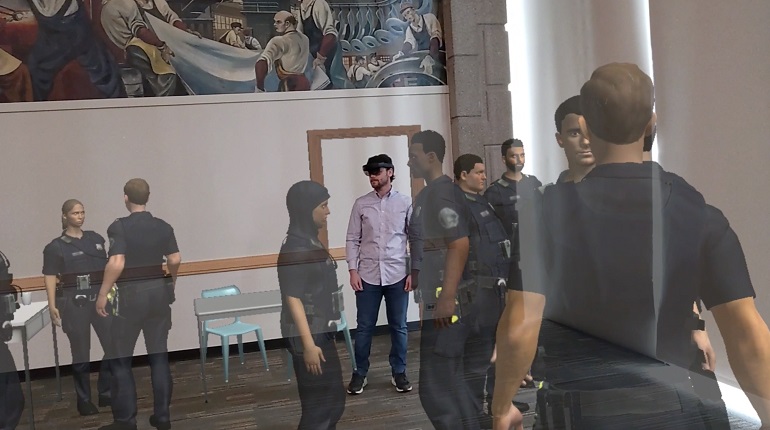
An international journal has published the first report showcasing treatment for post-traumatic stress disorder using augmented reality enhanced with artificial intelligence, a technology born, developed and tested at the Wayne State University School of Medicine.
“We are now able to create a world that feels real to the fear brain, and can be used in helping patients with PTSD in going back to the society and becoming functional,” said Professor of Psychiatry and Behavioral Neurosciences Arash Javanbakht, M.D. “Most current treatments mainly focus on symptoms of PTSD, while many patients are limited in their ability to do something as simple as going to a grocery store, a restaurant or their kid’s game. This technology specifically focuses on avoidances of the real-world environments the patients with PTSD are avoiding due to their trauma, and real-world social and occupational functioning.”
“Unreal that feels real: artificial intelligence-enhanced augmented reality for treating social and occupational dysfunction in post-traumatic stress disorder and anxiety disorders,” is included in this month’s issue of the European Journal of Psychotraumatology.

Dr. Javanbakht directs the Stress, Trauma and Anxiety Research Clinic, or STARC, and invented the technology.
Augmented reality, or AR, is an interactive human-computer technology that enables mixing virtually-created objects with reality. Instead of creating a completely synthetic environment, as with virtual reality, AR adds objects to the real world.
The purpose is to provide therapists with a variety of feared objects and situations at their command to use for exposure therapy, and help contextualize safety learning in as many real-life environments as possible. The patient’s AR headset wirelessly connects to the therapist’s computer, where the therapist can see a three-dimensional map of the patient’s environment.
“I believe this work further establishes the STARC and WSU nationally and internationally as pioneers in this technology, and will bring collaborations and expansion of use of this highly effective tool. I hope one day this technology will be regularly used in mental health clinics worldwide. That is when my efforts have paid off,” Dr. Javanbakht said.
He has been using AR technology in psychotherapy since 2016, first testing it in a research setting for treatment of phobias.
The journey to the most recent publication involved acquiring a patent, seeking seed pilot funding to create a minimum viable product for treating fear of spiders in collaboration with the industry, conducting and publishing successful clinical trials for treating fear of spiders and dogs, deep engagement with clinicians, leading industry and first responders in developing a fully operational one-of-a-kind technology with more than a 100 highly realistic humans of diverse age, sex, race and behavior, and incorporation of AI for automation of the characters.
One especially disabling symptom of PTSD is avoidance of anything that can resemble trauma or, in case of traumas caused by humans, most public situations. As a result, many patients with PTSD avoid going to a restaurant, movie, family events, work or even a grocery store.
“We needed to do a lot of trailblazing for this work, as such technology did not even exist in the world of entertainment when we started,” Dr. Javanbakht said. “It feels great to see how my team’s tireless work over the past decade, from conceptualization of the idea to a full clinically useable product, has paid off.”
As the technology is very novel and the latest version was released a few months ago, they were able to include feedback from several female police officers with PTSD, and a male firefighter, in the publication.
“It feels uniquely rewarding to serve those who truly put their lives on the line to protect us,” Dr. Javanbakht said. “Each stage involved a lot of creative problem solving, and I am proud to say that now we have a product that helps patients in the clinic.”
In addition to Dr. Javanbakht, the publication team included postdoctoral fellow Liza Hinchey, Ph.D.; STARC research manager Kathleen Gorski, LMSW; project coordinator Alex Ballard; AR industry expert Luke Ritchie; and Professor Alireza Amirsadri, M.D.
Learn more about the STARC Lab’s research, including the use of AR, at https://www.starclab.org/projects